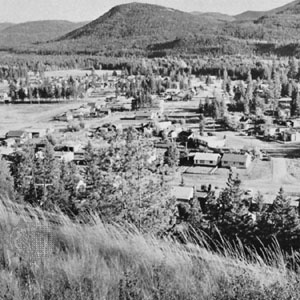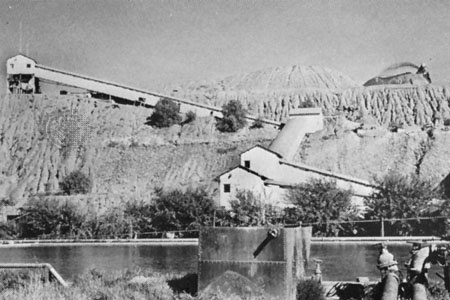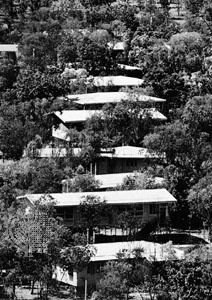Kimberley
British Columbia, Canada
 city, southeastern British Columbia, Canada. It is situated near St. Mary River, just northwest of Cranbrook. Built on the rolling slopes of the Sullivan and North Star hills, Kimberley is Canada's highest city (3,662 feet 【1,116 m】).
city, southeastern British Columbia, Canada. It is situated near St. Mary River, just northwest of Cranbrook. Built on the rolling slopes of the Sullivan and North Star hills, Kimberley is Canada's highest city (3,662 feet 【1,116 m】).The community dates from 1892, when the prospector Pat Sullivan staked his claim, leading to the development of the Sullivan lead-zinc mine, one of the world's largest. The Sullivan ore concentrator, a fertilizer factory, and an iron and steel plant are now the city's most important industrial establishments, while logging and sawmilling and winter sports facilities provide additional sources of income. Originally known as Mark Creek Crossing, the settlement was renamed Kimberley in 1896 after the South African mining centre. Its downtown buildings have been renovated in Bavarian style. The Kimberley Snow Fiesta is held annually in February. Inc. city, 1944. Pop. (2006) 6,139.
South Africa
 city, diamond-mining (diamond) centre, and capital of Northern Cape province, South Africa. It lies near the Free State province border. Founded after the discovery of diamonds on farms in the area in 1869–71, the mining camp of Kimberley grew as a result of the intensive digging of the diamond-bearing pipe at the hill called Colesberg Koppie. The camp was named after John Wodehouse, 1st Earl of Kimberley, who was then British colonial secretary. The town of Kimberley was created in 1878 and incorporated into the Cape Colony in 1880. In 1885 the Cape Town Railway reached Kimberley, and during the South African War the town was besieged by the Boers for 126 days until relieved by General John French on Feb. 15, 1900. City status was granted in 1912 with absorption of the mining town of Beaconsfield.
city, diamond-mining (diamond) centre, and capital of Northern Cape province, South Africa. It lies near the Free State province border. Founded after the discovery of diamonds on farms in the area in 1869–71, the mining camp of Kimberley grew as a result of the intensive digging of the diamond-bearing pipe at the hill called Colesberg Koppie. The camp was named after John Wodehouse, 1st Earl of Kimberley, who was then British colonial secretary. The town of Kimberley was created in 1878 and incorporated into the Cape Colony in 1880. In 1885 the Cape Town Railway reached Kimberley, and during the South African War the town was besieged by the Boers for 126 days until relieved by General John French on Feb. 15, 1900. City status was granted in 1912 with absorption of the mining town of Beaconsfield.After 1888 the Kimberley Mine at Colesberg Koppie and most other mines in the area were controlled by a trust organized by Cecil Rhodes, with production placed in the hands of De Beers Consolidated Mines Ltd. Kimberley Mine (now called the Big Hole; 0.9 mile 【1.5 km】 in circumference), long the richest diamond-producing mine in the world, was closed in 1915; but several other mines remain productive, and diamond mining and cutting remain prominent industries.
Kimberley's gardens and squares are dotted with memorials, including an equestrian statue of Rhodes. Important collections of Khoisan artifacts are in the Alexander McGregor Memorial Museum, and the Duggan-Cronin Bantu Gallery contains early 20th-century photographs of African miners. The city has Anglican and Roman Catholic cathedrals.
Kimberley is the main city of Griqualand West. It is the market and service centre for a prosperous irrigated-farming and cattle-raising area. Iron, salt, and gypsum are also worked in the vicinity. Pop. (2001) 62,526.
region, Australia
also called The Kimberleys,
 plateau region of northern Western Australia, extending from the rugged northwest Indian Ocean coast south to the Fitzroy River and east to the Ord River. With an area of about 140,000 square miles (360,000 square km), the plateau is composed chiefly of sandstone with patches of basalt (Kimberley Block) and is characterized by deep valleys such as the Geikie and Windjama river gorges. Rainfall is ample in northern West Kimberley but averages only 15 inches (380 mm) annually in southern East Kimberley.
plateau region of northern Western Australia, extending from the rugged northwest Indian Ocean coast south to the Fitzroy River and east to the Ord River. With an area of about 140,000 square miles (360,000 square km), the plateau is composed chiefly of sandstone with patches of basalt (Kimberley Block) and is characterized by deep valleys such as the Geikie and Windjama river gorges. Rainfall is ample in northern West Kimberley but averages only 15 inches (380 mm) annually in southern East Kimberley.The plateau, named for John Wodehouse, 1st Earl of Kimberley (British colonial secretary; 1870–74, 1880–82), has always been sparsely populated. In 1879 Alexander Forrest's expedition reported the area's suitability for grazing, and this encouraged permanent settlement. Discoveries of gold two years later brought a short-lived gold rush, but herding remained the principal basis of European settlement against a backdrop of conflict with the local indigenous population. Beef cattle are raised in the north and west, and meat is processed at Wyndham and Derby. Major irrigation projects along the Ord (Ord River) and Fitzroy (Fitzroy River) rivers (qq.v.) have made possible the growing of sugarcane, rice, and other semitropical crops. A new community, Kununurra, was built on the Ord in the 1960s as a service centre for development in that area, and the Division of Tropical Crops and Pastures operates the Kimberley Research Station nearby. Some mineral deposits, including kimberlite (diamond-bearing rock) and traces of oil, have been found on the plateau, and diamonds are now mined at Argyle. Several thousand Aborigines live in the region.
Kimberley is the name of a statistical division that roughly corresponds with the plateau. It comprises four shires: Broome, Halls Creek, West Kimberley, and Wyndham–East Kimberley. Pop. (2001) statistical division, 40,653.
- amine
- Amin, Hafizullah
- Amin, Idi
- amino acid
- Amino acid composition of soy protein
- Amino acid content of some proteins
- Amintore Fanfani
- Amiot, Jean-Joseph-Marie
- Ami Perrin
- Amir Ali, Sayyid
- Amirante Isles
- Amiri Baraka
- Amis and Amiles
- Amish
- Amis, Martin
- Amis, Sir Kingsley
- Amistad mutiny
- Amitabh Bachchan
- A. Mitchell Palmer
- Amiternum
- Amitābha
- Amitāyur-dhyāna-sūtra
- proletariat
- Proletkult
- proline